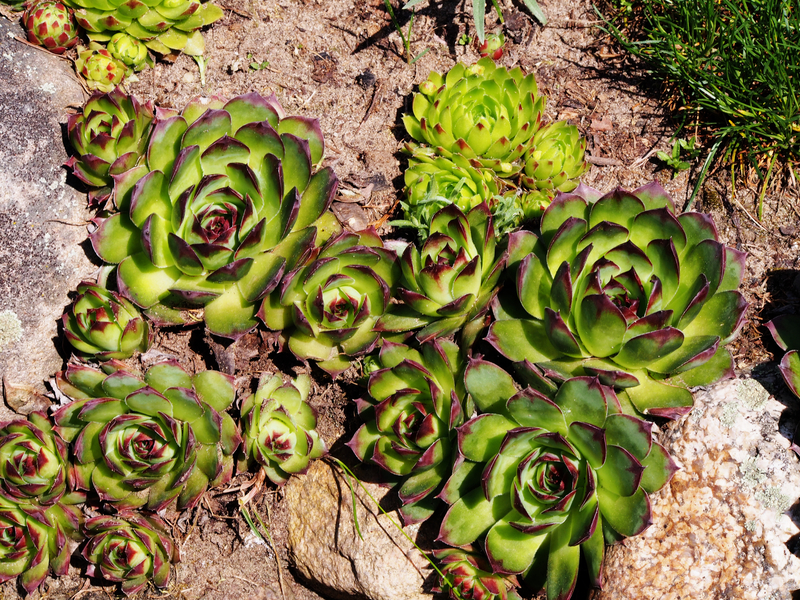Nature's Blueprint: Using Gardens to Combat Climate Change
Posted on 19/09/2025
Nature's Blueprint: Using Gardens to Combat Climate Change
As climate change intensifies, humanity seeks innovative solutions to mitigate its looming impact. While global efforts often emphasize technology and policy shifts, we must recognize a potent ally right at our doorsteps: gardens. Through thoughtful design and mindful plant choices, gardens can serve as nature's blueprints--sustainable sanctuaries that actively combat climate change. This article delves deep into how gardening for climate change is not only possible but essential.

Understanding the Connection: Gardens and the Climate Crisis
Climate change is primarily driven by increased greenhouse gas emissions, loss of biodiversity, and degraded natural carbon sinks. Amidst these challenges, gardens emerge as micro-ecosystems that can sequester carbon, foster biodiversity, manage water, and create cooler microclimates.
- Carbon Sequestration: Plants absorb CO2 during photosynthesis, storing it in their tissues and the soil.
- Biodiversity: Diverse gardens support pollinators, birds, and beneficial insects, maintaining ecosystem balance.
- Urban Cooling: Green spaces reduce the urban heat island effect, lowering local temperatures.
- Water Management: Sustainable gardens improve rainwater infiltration and reduce runoff.
How Gardens Become Climate-Change Champions
Maximizing the climate-fighting potential of gardens requires strategic design and plant selection. From urban rooftops to suburban backyards, every cultivated plot can contribute to planetary health.
Gardening Strategies to Combat Climate Change
1. Planting Carbon Sink Gardens
Carbon sinks absorb more carbon dioxide than they release, helping offset emissions from industries and transportation. Gardeners can create carbon sinks by:
- Choosing native trees and shrubs: These generally require less maintenance and sequester large amounts of carbon over time.
- Layering vegetation: Combining ground covers, perennials, shrubs, and trees for maximum photosynthetic activity.
- Embracing perennial plants: Perennials store more carbon in their root systems compared to annuals.
By thoughtfully designing your garden as a miniature forest, you enable long-term carbon storage, emulating the patterns of natural ecosystems.
2. Biodiverse Gardens for Resilience and Wildlife
Biodiversity is a linchpin in climate change resilience. Diverse gardens are less vulnerable to pests, diseases, and extreme weather. They also serve as vital refuges for wildlife displaced by habitat loss.
- Incorporate native plant species to attract pollinators like bees and butterflies.
- Add layered plant heights to provide shelter for birds and insects.
- Grow flowering plants with staggered bloom times for a continuous food source.
- Allow patches of leaves or logs to decompose, creating habitats for beneficial fungi and insects.
A biodiverse garden follows nature's blueprint, resulting in a healthier climate and resilient ecosystems.
3. Sustainable Practices: Organic, No-Till, and Mulching
The foundation of eco-friendly gardening lies in minimizing disturbance and chemical inputs.
- No-till gardening: Disturbing the soil releases stored carbon; keeping soil intact helps lock carbon underground.
- Organic methods: Avoid synthetic fertilizers and pesticides, which are carbon-intensive to produce and can harm soil microbes.
- Mulching: Organic mulches like wood chips and straw regulate soil temperature, retain moisture, and add carbon-rich organic matter.
Such regenerative gardening practices mirror natural processes, nurturing richer soils and healthier plants that sequester even more carbon.
4. Water-wise and Climate-adaptive Gardening
As rainfall patterns become unpredictable, water-efficient gardens are vital. Drought-resistant gardens and rain gardens are two approaches worth considering.
- Install rainwater harvesting systems to capture and reuse rainfall.
- Grow drought-tolerant plants that thrive on minimal irrigation.
- Design rain gardens or swales to absorb stormwater and recharge groundwater.
- Use permeable surfaces and mulch to minimize runoff and evaporation.
These water-wise strategies not only lessen the garden's footprint, but also help prevent urban flooding and erosion--contributing further to climate adaptation.
5. Urban Greening: Rooftop and Vertical Gardens
City dwellers can be climate heroes, too! Urban gardening for climate action transforms dull spaces into vibrant, productive oases.
- Rooftop gardens: Insulate buildings, absorb CO2, and reduce energy usage for cooling.
- Vertical gardens: Green facades improve air quality and buffer heat, especially in concrete-rich areas.
- Edible landscaping: Incorporate food production, reducing the carbon footprint of transporting produce.
These green interventions not only beautify cities but also actively offset urban carbon emissions and enhance human well-being.
The Science: How Gardens Influence Carbon, Water, and Local Temperatures
1. Carbon Sequestration - The Garden Advantage
Every plant in your garden acts as a carbon sponge. Through photosynthesis, plants absorb carbon dioxide from the atmosphere and convert it into organic matter, which is stored in roots, stems, leaves, and soil. Perennial trees and shrubs are the stars here, locking away carbon for decades.
- Trees: Mature trees can sequester up to 22 kg (48 lbs) of CO2 per year, per tree.
- Soil: Healthy, compost-rich soil stores significant amounts of organic carbon.
- Mulch and compost: Decomposing plant material increases soil carbon storage.
On a larger scale, if every household optimized their green spaces as carbon sinks, the cumulative climate benefit would be extraordinary.
2. Water Management: Gardens as Natural Sponges
Sustainable gardens regulate water flow, absorb excess rainfall, and minimize flooding during storms. Deep-rooted plants and permeable soil structure encourage rain absorption rather than runoff.
- Rain gardens and bioswales filter out pollutants and recharge aquifers.
- Green spaces retain moisture, ensuring water is available during dry periods.
- Reducing impervious surfaces (like concrete) prevents urban flooding.
3. Urban Heat: Gardens as Cool Islands
Urban areas trap heat due to dense construction and minimal vegetation, causing the "urban heat island" effect. Research shows that gardens can reduce local temperatures by up to 2-3?C (3.5-5.5?F) through shade, evapotranspiration, and reflective surfaces from leafy vegetation.
These microclimates help reduce air conditioning usage and energy demand, further shrinking the city's carbon footprint.
Gardening for Climate Change: Practical Steps for Every Gardener
Getting Started: Small Changes, Lasting Impact
Every sustainable garden begins with small, intentional steps. Whether you're working with a window box, a modest backyard, or a large property, these principles apply:
- Assess your site: Know your soil type, sun exposure, and native plant options.
- Choose climate-appropriate plants: Opt for species adapted to your local conditions--that means less water, fertilizer, and fuss.
- Reduce your lawn: Lawns require frequent mowing, watering, and fertilizing. Convert sections into wildflower meadows or edible gardens.
- Create wildlife habitats: Include plants that feed birds, pollinators, and insects. Add water bowls, birdhouses, and log piles.
- Compost: Turn kitchen and garden waste into organic fertilizer, reducing landfill emissions.
Year-Round Gardening for Climate Adaptation
- Spring: Start seeds indoors, mulch garden beds, and plant native perennials.
- Summer: Conserve water, harvest rainwater, and monitor for drought stress.
- Autumn: Leave fallen leaves to feed soil and shelter wildlife. Plant trees and shrubs.
- Winter: Plan your garden layout, source seeds, and mend garden equipment.
Community Gardens: Taking Local Action Against Climate Change
Community gardens bring people together and multiply climate benefits. They promote equitable access to green spaces, food production, and environmental education--all while combating urban heating and CO2 emissions.
- Organize workshops on composting and water conservation.
- Share seeds and plant cuttings to diversify local flora.
- Collaboratively install rain gardens and pollinator habitats.
Collective gardening efforts amplify nature's blueprint, making cities greener and more climate resilient.
Real-World Examples: Gardens Driving Climate Solutions
1. Singapore's "Garden City" Transformation
Singapore is renowned for its city-wide commitment to green spaces. Vertical gardens, rooftop parks, and tree-lined boulevards have not only improved public health but also reduced the urban heat island effect and bolstered biodiversity--providing a blueprint for integrating nature into megacities.
2. The Pollinator Pathway Initiative
Across North America and Europe, Pollinator Pathways link home gardens, public parks, and vacant lots, creating continuous habitats for bees, butterflies, and birds. These corridors ensure pollinator survival, food security, and resilient urban ecosystems, all while capturing carbon in their abundant green biomass.

The Future of Climate-Smart Gardening
The movement to use gardens against climate change is gathering momentum. As more people recognize the interdependence between gardens and the global climate, innovative gardening techniques continue to evolve:
- Edible forest gardening: Mimics natural woodlands to maximize food production, biodiversity, and carbon storage.
- Permaculture: Designs self-sustaining habitats with overlapping layers, yielding both food and ecosystem services.
- Green walls and roofs: Advanced systems for dense urban landscapes, improving insulation and filtering air.
- Smart irrigation: Incorporates sensors and automation to minimize water use.
These advancements further expand the role of gardens as climate solutions, enabling every gardener to contribute to a livable planet.
Conclusion: Nature's Blueprint--The Garden Revolution in Climate Action
Our gardens are more than just places of beauty or fresh food. They are living, breathing extensions of nature's blueprint--a resilient, carbon-capturing, climate-cooling force. By embracing climate-smart gardening practices, we unlock gardens' potential to slow climate change while enriching our own lives.
As you plan your next planting, remember: Every seed sown and every green corner nurtured is a step toward a sustainable future. Let's cultivate hope, resilience, and healing--one garden at a time.
Frequently Asked Questions (FAQs)
- How can I start climate-friendly gardening if I have limited space?
- Container gardens, window boxes, and vertical gardens are ideal for small spaces and still offer carbon, cooling, and biodiversity benefits.
- What are the best plants for climate-resistant gardens?
- Native perennials, drought-tolerant species (like lavender or sedum), and deep-rooted trees are all excellent choices.
- Can using compost really fight climate change?
- Absolutely! Compost reduces landfill waste and adds organic carbon to your soil, enhancing its carbon-sequestering capacity.
Harness nature's blueprint in your garden today, and join the global movement to combat climate change from the ground up.

